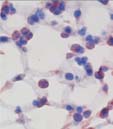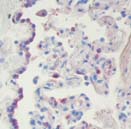| HOME | METHODS | LINKS | NEWS | POLLS | FORUM | CONTACT | SEARCH |
| HOPE = Hepes-glutamic acid buffer mediated Organic solvent Protection Effect |
|||||
|
he HOPE-fixation technique§ starts with an incubation of fresh tissue specimens in an aqueous protection-solution overnight at low temperatures of 0-4°C followed by an incubation in acetone at 0-4°C. Tissues treated in this manner can be directly embedded with paraffin. The protection-solution is hyperosmolar, containing a mixture of different amino-acids (with concentrations of 10-100 mM), and exhibits a pH of 5.8-6.4 at room temperature. When the specimens are submerged in the protection-solution it penetrates the tissues by diffusion, in the manner of immersion-fixatives. This reduces the destructive effects of the next step, the incubation with the organic solvent acetone. The procedure has been optimized to precipitate the compounds of the protection-solution during infusion with acetone in the second step. This removes most of the HOPE-solution from the tissue leaving only small amounts which are necessary for further protection in the next fixation step. Dehydration by acetone and (reversible) denaturation of proteins are achieved in parallel since denaturation is kept to a minimum and this results in the preservation of nucleic acids and antigenic-structures. An additional effect of the protection-solution is to open capillaries for the infusion of acetone, thus accelerating the penetration of acetone into the tissues. After dehydration the specimens are directly transferred into low melting paraffin (Tm=52-54°C). The residues of the HOPE-solution again protectively act upon the in-floating ”solvent” paraffin and are thus finally removed from the tissue together with the acetone. Incubation in paraffin is carried out at 54°C for 12-16h. The further processing of the blocks is similar to that of standard formalin-fixed, paraffin-embedded specimens. § German patent application 10021390.1-52. Inquiries concerning further technical information can be directed to Dr. Jürgen Olert, Abt. Kinderpathologie, Universitätsklinikum, D-55101 Mainz, Germany. HOPE fixation reagents are avaliable from DCS-Diagnostics Results obtaining using HOPE technology (kindly provided by DCS)
RT- PCR
Fig.1 313 bp amplicon from HOPE-fixed tissue as evidence for intact mRNA >0.7kb. |
|||||
| \TECHNOLOGIES\Histology\HOPE | |||||
| © Copyright 1999-2006 Alexei Gratchev. All rights reserved. | |||||





